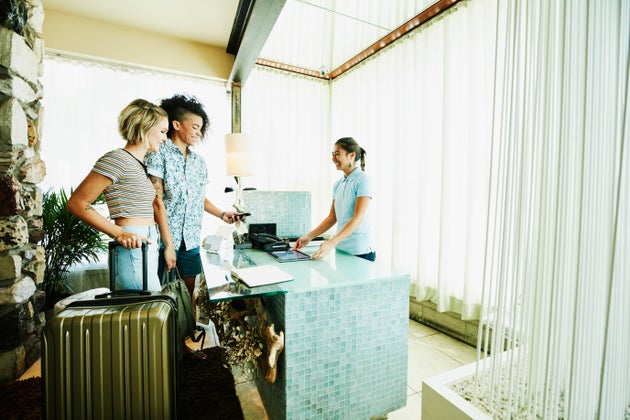Understanding the Hidden Germs in Hotel Lobbies
When you step into a hotel lobby, your primary focus is usually on checking in, managing your luggage, and finding the elevator to your room. However, there’s one aspect you might not be thinking about: the numerous contaminated surfaces you’ve touched before even reaching your room. These areas can harbor a variety of germs that could potentially make you sick.
According to microbiologist Jason Tetro, author of “The Germ Code,” hotel lobbies should be considered similar to hospital waiting rooms. Both are spaces where people gather, making them ideal for the spread of germs. A recent study examined contaminated surfaces in common hotel lobby areas, including check-in counters, elevators, lounges, bars, office spaces, gyms, and restrooms.
Dr. Kelly Reynolds, an environmental scientist at the University of Arizona’s College of Public Health and a researcher for the study, noted that just a few heavily used surfaces can quickly spread germs throughout a hotel lobby. “Because so many people touch the same spots, germs can jump from hand to hand, to face, and even to food,” she explained.
The Germiest Spots in a Hotel Lobby
Tetro emphasized that high-touch environmental surfaces are the main places where germs hide. According to the study, the most-touched site in the hotel lobby is the elevator button, which receives about a third of all touches. Elevator buttons act as a central hub, connecting people to other parts of the lobby and spreading germs easily.
The front desk counter ranked second for the most touches, followed by tabletops, bar tops, and buffet countertops in food service areas. These surfaces are particularly concerning because people often touch their mouths while eating, allowing germs to travel from hands to food.
Entry door handles, especially those from parking garages into the lobby, are also risky. The study placed a harmless virus on these surfaces to track its spread, and it impacted about half of all targeted surfaces. Even though bathroom door handles aren’t touched as much as other areas, they remain important to be aware of. People using the bathroom might not wash their hands well, which can spread harmful fecal bacteria.
Upholstered chairs in the lobby were also found to be contaminated. These surfaces are often overlooked during cleaning, and even when cleaned, the porous nature of woven fabrics makes it difficult to remove germs effectively.
Common Germs Found in Hotel Lobbies
In any area, you’re likely to encounter viruses that cause respiratory infections. Dr. Shira Doron, chief infection control officer for Tufts Medicine, explained that people often cough or wipe their noses with their hands, transferring germs to surfaces. Bugs like the flu, RSV, COVID, and the common cold are commonly found in such environments.
Bacteria that cause food poisoning, such as salmonella and campylobacter, are more likely to be found in food service areas or bathrooms. Other gastrointestinal pathogens, like norovirus, are also more prevalent in the bathroom. Skin microbes such as Staphylococcus can also be found on hotel lobby surfaces, potentially leading to severe illnesses if they enter deeper into the body.
How Likely Are You to Get Sick?
The likelihood of getting sick depends on various factors, including the type of germ, the hotel’s cleaning protocols, and your immune system. To actually get infected, there needs to be a sufficient amount of the bacteria or virus, known as the minimal infective dose. For example, the amount needed to get sick from norovirus is just one, while E. coli requires around 100,000.
The hotel’s cleaning procedures for the lobby also play a significant role. Using effective disinfectants on high-touch surfaces can reduce infection risk by over 97%, according to Reynolds. Even if you do pick up germs, your immune system may be able to fight them off before you get sick.
Tips to Avoid Getting Sick
To minimize the risk of picking up germs, experts recommend taking precautions. Dr. Doron advises being careful not to touch your face without washing your hands, especially after touching surfaces like credit card machines and elevator buttons. Bringing a bottle of hand sanitizer with 62-70% ethanol is also recommended. Make sure to use enough to cover your hands and rub it in for about 20 seconds.
Washing your hands with soap and water is also effective, provided you scrub properly for about 15 seconds. Pay attention to your fingertips, as they are the first point of contact with surfaces. Moisturizing your hands regularly is also important, especially if you’re doing a lot of handwashing, to counteract the drying effects of hygiene products.
Maintaining a healthy immune system through regular exercise, good sleep, nutritious food, and stress management is crucial. People with compromised immune systems are at higher risk of becoming sick after exposure to pathogens.
Conclusion
Even if you’ve touched an elevator button that hundreds of people have pressed before you, taking less than a minute to properly wash or sanitize your hands after can make all the difference. By understanding the hidden germs in hotel lobbies and taking the necessary precautions, you can significantly reduce your risk of illness.



